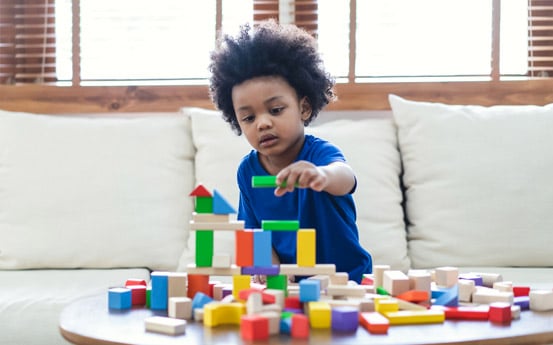When I was in preschool, my grandma gifted me a wooden puzzle stool. She had the letters of my name made into puzzle pieces that fit on the surface of the seat. It was such a special gift, and one that I played with for many, many hours during my childhood.
What my grandma didn’t know is that the majority of the hours spent in play with the stool were with its removable legs. I would detach the legs of the stool and play with them instead of the puzzle! They were breadsticks for my Italian restaurant, rolling pins for baking, or wands for my magic shows. The legs of my puzzle stool could be anything that I wanted them to be.
There have been countless studies throughout history on the ways in which young children learn. The conclusion? Play. Children need ample opportunities to play in order to support healthy, holistic development. While “playing” seems like a simple concept, there are many different types of play that support different areas of development. Dolls can support social-emotional skills as children explore emotions and relationships, toy cars can support motor skills as children enhance hand-eye coordination and dexterity...but what about a box? Open-ended play involves the use of simple materials and a whole lot of imagination. There is no objective, no end-goal, no game plan. Children simply breathe life and meaning into seemingly ordinary items. Boxes become spaceships, rocks become people, and marker lids become painted fingernails. Out of all the toys that I engaged with as a child, the play that I remember most was with items that were not even typical toys at all. This, my friends, is the magic of open-ended play.
Why Open-Ended Play?
Promotes Healthy Development
Aside from the fact that it’s just plain fun, there are many developmental benefits to open-ended play. When children assign meaning to objects, they are engaging in what’s called symbolic play. The more opportunities that children have to engage in symbolic play, the more complex their cognitive functioning will become. This higher-order thinking promotes healthy brain development in young learners! In addition, children may develop increased stamina with a task, collaboration skills as they work with others, and self-confidence as they take pride in their creations.
The Power of Choice
The NAEYC Principles of Developmentally Appropriate practices states that the three components to play are choice, wonder, and delight. Choice is a powerful motivator for a child. Imagine if you, as an adult, were given the opportunity to paint a picture of your choosing. It would be much more meaningful for you to choose the images and colors that you like the most, instead of someone choosing how you paint and what colors to paint with! Choice is even more important with young children. Children’s ownership in play leads to a deeper, longer-lasting play experience. Open-ended play also naturally lends itself to promote wonder within a child. Wonder is created when children can manipulate and explore objects and assign meaning. Finally, delight is a necessary component to play as children’s deepening sense of joy emerges from creating. We all love doing things that we enjoy!
Multi-Age Play
Since there is no concrete objective in open-ended play, children of varying ages and ability levels have opportunities to engage in play with the same objects. For example, a one-year-old and a five-year-old can use the same basket of wood slices for play that is developmentally appropriate for their ages. The five-year-old may use the wood slices to build a house for their Lego figurines to live in, while the one-year-old may repeat the activity of filling and dumping the basket with the wood slices. Open-ended play materials would make a wonderful addition to any playroom, but especially the playroom of multi-aged children! *Please note that children that are still frequently mouthing toys as a means of exploration (typically ages three and under) should not be given play materials that are smaller than what can generally fit inside of a toilet paper roll.
So, where to begin? Here are five practical steps to support open-ended play for children:
- Begin your collection –This is much easier and cheaper than it sounds! Start looking in your recycling bin for boxes. Save the lids to baby food pouches or candles. Take a nature walk with your child and collect sticks, rocks, or pinecones. Having a collection with varying sizes, shapes, and materials is a great place to start. Most home improvement stores have a plethora of scrap materials that could be used as well. Including children in the collection of items will aid in engagement when play time begins.
- Swap out materials –Children have many toys that have one objective or purpose (the plastic head of broccoli will most likely remain a plastic head of broccoli in play). We absolutely want children to keep engaging with those items to build upon other important skills, but consider switching up these toys with open-ended play materials. Dress up clothes can be rotated out with scarves and pieces of fabric. I’ve seen children use the same scarf as a cape, a skirt, and a gauze wrap for an injury. A set of Legos may even be replaced with a bin of pinecones. The possibilities are endless!
- Adopt a “less is more” approach –Research shows that, when presented with too many choices, children are less likely to remain engaged in play with one type of material for long. Providing children with fewer choices and less clutter will allow for longer periods of engagement. Develop a rotation system with toys and materials so that only a few items are out at one time.
- Move one material to a different area of play –This takes a significant amount of trial and error but could actually be quite a fun little experiment! If your child has stopped playing with a certain material inside, move that material outside or in your kitchen. Sometimes the same object in a different area sparks more creativity.
- Model and step back –Seeing a bin of pebbles in the playroom may be puzzling to some children. If your child is hesitant or unsure of how to play with a certain material, model what can be done with that material while you play. If you are pretending to cook with your child in the play kitchen, model your thought process aloud. “I’m really craving some macaroni and cheese! Hmm, I’ll pretend these rocks are my noodles. I’ll put them in my pot of boiling water. Next I’ll add the cheese!” You can also use prompts such as “I wonder what we can do with these rocks today”. Repeat these situations as they appear until your child begins to show signs of engagement. When a child begins to pick up on the pretend play, step back and watch their creativity at work. It can be challenging not to interfere or make suggestions beyond this point, but children tend to have richer play experiences with less direction.
I wish you all many wonderful, meaningful moments of play with your little ones! You may even be creating moments that your children will remember twenty plus years from now. In fact, at this exact moment, my beloved name puzzle stool sits right by my feet. Even better, sitting next to it is an identical stool with my ten-month-old daughter’s name on it. One day I might show her that she can use the legs of her stool as breadsticks. For now, I will follow her lead and let her figure that out for herself.



